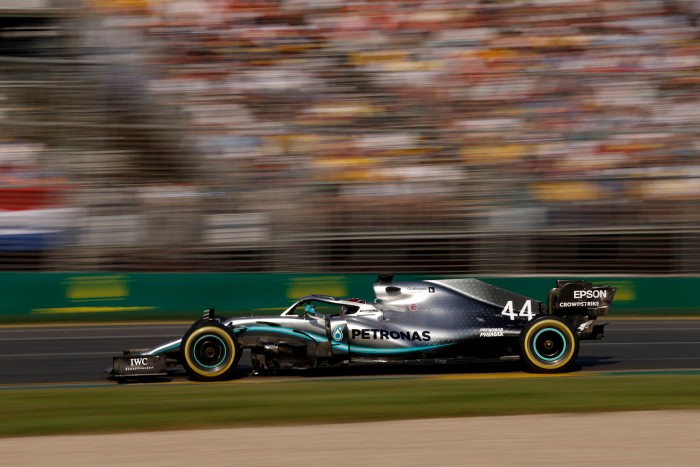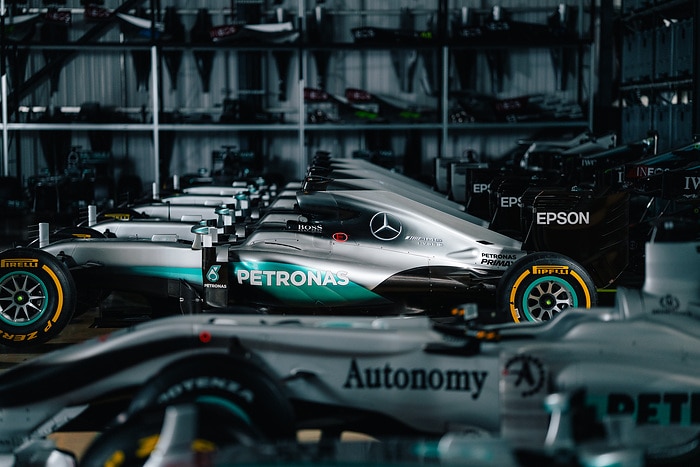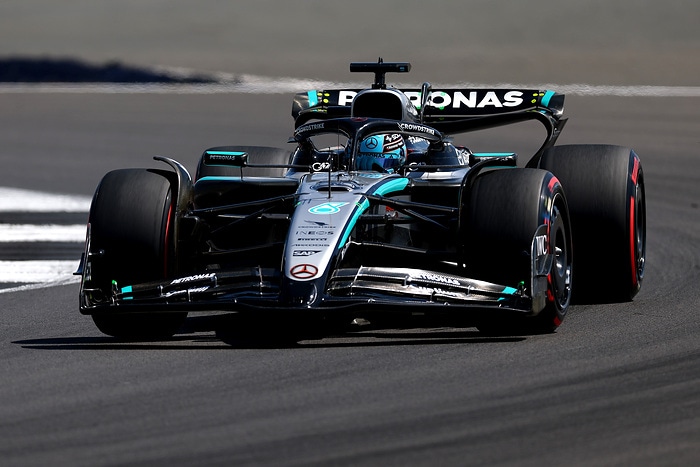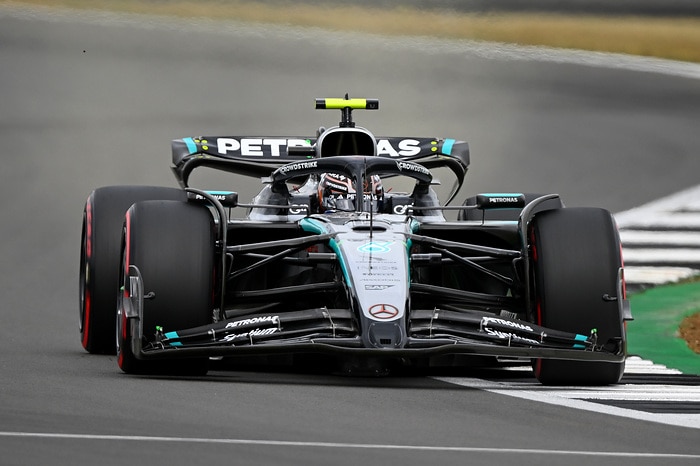
Looking ahead to the second race of the 2019 Formula One season in Bahrain
- Toto Talks Bahrain
- Featured this Week: Racing in the Desert
- Stat Attack: Bahrain and Beyond
Toto Talks Bahrain
Claiming the maximum 44 points race from the first race was a fantastic result, we could not have asked for a better start to the season. But the fight has only just begun: Ferrari will try everything they can to hit back and Melbourne showed that Red Bull will have something to say in the fight, too. We’ve seen the potential of Ferrari’s package in Barcelona, so we expect them to come back strong in Bahrain, with Red Bull in the mix as well.
We will see a very different race in Bahrain, where the weekend presents unique challenges, especially the change in conditions between the sessions. FP1 and FP3 take place in the middle of the day when both the air and the track can be very hot; FP2, Qualifying and the Race on the other hand are held in the evening in considerably cooler temperatures. These temperature swings make it very tricky to set up the car and find the right configuration for the sessions that really count.
After the Barcelona test, we felt that we were the challengers. Whatever the Melbourne result says, our mindset hasn’t changed since then. One race doesn’t determine the pecking order for the rest of the season. We need to extract every bit of performance from our package and keep on working hard to improve the car over the weekend to be competitive. We’ve had some great racing in recent years in Bahrain, so I’m looking forward to an exciting weekend.
Featured this Week: Racing in the Desert
Formula One heads to Bahrain for the second round of the 2019 season. Located in the middle of the desert, the Bahrain International Circuit presents several challenges – from the heat to sand on the track and an offset schedule. Today, we’re taking a look at how F1 teams deal with those challenges.
What kind of temperatures can we expect in Bahrain?
In recent years, we’ve seen air temperatures climb up to 38 degrees Celsius and more in the middle of the day, with track temperatures creeping up to the mid to high 50s. While we do see extremely high temperatures in the middle of the day, both the track and the ambient temperature cool down significantly when the sun sets. With FP2, Qualifying and the Race taking place at 18:00 local time, those sessions are usually held in more comfortable conditions, with outside temperatures in the mid-to-high 20s or low 30s and asphalt temperatures in the mid-30s. This year, however, temperatures are forecast to be a little cooler, with even some light rain predicted in the days leading up to the weekend.
How do F1 cars react to high temperatures
A number of components, particularly the Power Unit, the gearbox and the electrical systems, would sustain damage if the team was to run them above their temperature limits for prolonged periods of time. So, when the W10 is run in a hot climate, the team has to open up the bodywork of the car for additional cooling in order to prevent those components from overheating. However, opening up the bodywork means losing aerodynamic performance as the additional air inlets produce drag and also disturb the air flow around the car, negatively impacting the efficiency of the rear wing and the diffuser. Depending on which aero configuration the team runs, the difference in lap time can be quite substantial; a completely closed-up car would be several tenths of a second per lap faster compared to one that is opened up for maximum cooling.
Can the teams run a different cooling configuration in Qualifying and the race?
Yes and no. The regulations specify that F1 teams have to start the race with the same cooling configuration they ran in Qualifying, meaning that the cooling can’t be changed in Parc Ferme. However, the bodywork can potentially be opened up during a pit stop, should the sensors on the car indicate that certain components are running hot. One area that is relatively easy to open up is a cooling panel below the headrest area. The louvers in that panel can be covered up for Qualifying and the first stint, with the cover easily removable in a pit stop to add another three to five percent of extra cooling for the second stint.
FP1 and FP3 take place in the heat of the day; FP2, Qualifying and the Race take place in the cooler temperatures of the evening. What implications does that have?
The change in ambient conditions between the sessions means that the amount of representative running is limited. FP2 is the only practice session with similar conditions to the race, so the teams will focus on their race programmes on Friday evening. While the heat of FP1 might not be ideal for doing long-run simulations, the session is still useful to work on other items. Teams might test new parts or work on their understanding of the 2019 tyres, knowing that the hot conditions are harsh on the tyres and lead to quick degradation and rear overheating. The first session on Saturday is usually devoted to single-lap performance with the drivers doing a lot of cool down laps to get the tyres back into the temperature window for the start of the next lap.
How useful is the data from FP1 and FP3 for the rest of the weekend?
While the majority of the race preparation is conducted in FP2, teams can still do a bit of set-up work in the hot sessions. However, it is crucial to not to get misled by the big swings; so the teams have to be extra careful to make the right adjustments to the balance of the car, so that the cars are not tuned for the wrong conditions.
Are there any other circumstances that make racing tricky in Bahrain?
The Bahrain International Circuit is located on a former camel farm in a rural and flat area, surrounded by desert and sand, with winds easily sweeping sand onto the track. When Formula One first came to Bahrain, engineers were wondering if the sand might have a detrimental effect on the car systems and if they might need special filters to keep the sand out. Today, 15 years later, we know that no special filters are required; however, the sand does have an abrasive effect, which has a negative impact on the aero surfaces. The track does clean up relatively quickly though. Once 20 cars have gone by, the tarmac is in a much better condition. This means the biggest impact of the sand is to the start of the sessions, as it can create a bit of a standoff as the teams all wait for others to go out and clean the track.
Stat Attack: Bahrain and Beyond
|
2019 Bahrain Grand Prix Timetable |
|||
|
Session |
Local Time (AST) |
Brackley (GMT) |
Stuttgart (CET) |
|
Practice 1 Friday |
14:00-15:30 |
11:00-12:30 |
12:00-13:30 |
|
Practice 2 Friday |
18:00-19:30 |
15:00-16:30 |
16:00-17:30 |
|
Practice 3 Saturday |
15:00-16:00 |
12:00-13:00 |
13:00-14:00 |
|
Qualifying Saturday |
18:00-19:00 |
15:00-16:00 |
16:00-17:00 |
|
Race Sunday |
18:10-20:10 |
16:10-18:10 |
17:10-19:10 |
|
Race Records – Mercedes F1 at the Bahrain Grand Prix |
|||||||
|
|
Starts |
Wins |
Podium Places |
Pole Positions |
Front Row Places |
Fastest Laps |
DNF |
|
Mercedes |
8 |
3 |
10 |
5 |
8 |
4 |
0 |
|
Lewis Hamilton |
11 |
2 |
7 |
2 |
6 |
1 |
0 |
|
Valtteri Bottas |
6 |
0 |
2 |
1 |
1 |
1 |
0 |
|
MB Power |
14 |
4 |
16 |
5 |
10 |
6 |
4 |
|
Technical Stats – Season to Date (Barcelona Pre-Season Test 1 to Present) |
||||
|
|
Laps Completed |
Distance Covered (km) |
Corners Taken |
Gear Changes |
|
Mercedes |
1,489 |
7,125 |
23,824 |
67,304 |
|
Lewis Hamilton |
785 |
3,749 |
12,560 |
35,472 |
|
Valtteri Bottas |
704 |
3,375 |
11,264 |
31,832 |
|
MB Power |
3,242 |
15,648 |
51,872 |
146,750 |
|
All-Time Records – Silver Arrows in Formula One |
||||||||
|
|
Starts |
Wins |
Podium Places |
Pole Positions |
Front Row Places |
Fastest Laps |
1-2 Finishes |
Front Row Lockouts |
|
Mercedes |
190 |
88 |
181 |
102 |
181 |
67 |
45 |
58 |
|
Lewis Hamilton |
230 |
73 |
135 |
84 |
133 |
41 |
N/A |
N/A |
|
Valtteri Bottas |
119 |
4 |
31 |
6 |
18 |
11 |
N/A |
N/A |
|
MB Power |
460 |
174 |
449 |
185 |
361 |
162 |
76 |
97 |
Source: Mercedes-Benz F1






















